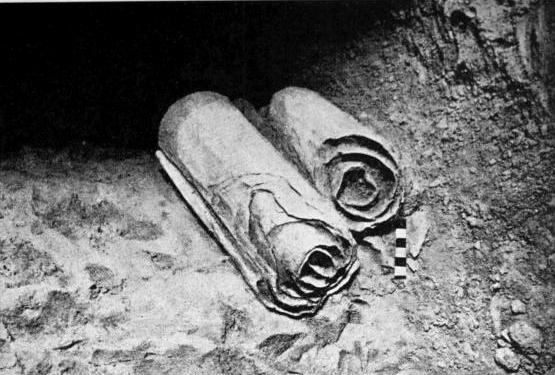From the hidden treasure trove of the pirate Samuel Bellamy to the misplaced remains of the bizarre and mysterious Pedro Mountain Mummy, lost artifacts and treasures are scattered throughout history and sought after by fortune-hunters and historians alike. Amongst all of history’s most intriguing unsolved mysteries, few can hold a candle to that of the so-called Copper Scroll.
More Mysterious History: The Intriguing Mystery of the Disappearance of the Explorer Percy Fawcett and the Lost City of Z
What is the Copper Scroll?
To begin our journey into the strange mystery of the Copper Scroll, we must first examine the Dead Sea Scrolls. Discovered in the late nineteen forties and fifties in a series of caves along the shores of the Dead Sea, the Dead Sea Scrolls are a collection of ancient manuscripts dating back as far as the third century BC. The scrolls span a large period of years and are written in several different languages, most being Hebrew. From copies of the Bible to previously unknown apocryphal works, the Dead Sea Scrolls introduced a previously hidden section of history to the world when they were uncovered. (1)

Now, we turn to the Copper Scroll. In 1952, archeologists investigating the Dead Sea Scrolls discovered a document which poses almost as much mystery to modern audiences as it did when it was first discovered. Written on thin sheets of copper, wound tightly together such that the scrolls had to be cut into strips and reconstituted to be read, the Copper Scroll is best described as a treasure map. (2)
The Copper Scroll consists of sixty-four instructive passages which describe to the reader the specific locations, contents, and values of sixty-three hidden treasures. Most of the treasures are described as hidden caches of gold and silver which, if found today, would be worth untold millions. (3)
More Strange Artifacts: The Four Golden Hats: Mysterious Bronze Age Artifacts are More Than They Appear to Be
Who Wrote the Copper Scroll?
While the promise of buried treasure is alluring, the nature and origins of the scrolls themselves present a mystery almost as tantalizing. The scroll was found in the back of a cave in two parts. The two tightly rolled sheets of corroded metal were initially impossible to read or to even untangle, but after carefully disassembling them, their contents were made known. Hammered into the thin copper rolls was a single document seemingly written in a form of Mishnaic Hebrew. This is significant. Mishnaic Hebrew is the language in which the Mishnah, a Jewish law code from about 200 AD, was written. This is different from the other scrolls found within the same cave, and indeed from all of the other Dead Sea Scrolls which were largely written in biblical Hebrew, Greek, and Aramaic. This has led to some curiosity surrounding the dating and authorship of the Copper Scroll. (4)
On the subject of authorship, it is believed by some some scholars that the creator or creators of the scroll might have been somewhat less literate than the authors of the Dead Sea Scrolls. Hammered clumsily with mistakes and corrections throughout, the Copper Scroll is believed by some to be the work of simple metal-workers tasked with preserving information passed to them by someone else.
Some, however, suggest that the scroll describes the treasures belonging to a temple; treasures which were spirited away to so many hiding places in and around Jerusalem and Jericho. The working theory, then, is that this temple, perhaps the legendary Temple of Jerusalem, hid its treasures to avoid them being seized, and created a metal scroll to serve as an indestructible guide so that they might be safely recovered once the danger had passed. (5)
More Amazing History: Who was Grutte Pier? The Tall Tale of the Noble Pirate Pier Gerlofs Donia
Are the Treasures From the Copper Scroll Real?
So, are the treasures described by the Copper Scroll really out there for the taking? The answer is a hesitant maybe. Many scholars believe that the scroll itself is a work of fiction. Some, in fact, think that the treasures described therein are legendary ones; a fantastical tradition chronicling the legendary second Jerusalem Temple which was integral to the folklore of the period. (6)
Others, however, maintain that the treasure is credible. Why would this scroll, of all of the Dead Sea Scrolls, be recorded in such a permanent way, with copper as a medium? For hopeful treasure hunters, this is evidence that the caches of gold and silver still lie beneath the earth of modern day Jerusalem. Some of the more far-fetched theories suggest that the Copper Scroll is the secret to discovering the Ark of the Covenant, or other such biblical treasures. (7)
Such theories continue to generate interest and spawn search efforts to this day. With no end in sight to the mystery of the Copper Scroll, we are left to wonder whether this document represents one of history’s longest standing mysteries or one of its oldest wild goose chases.